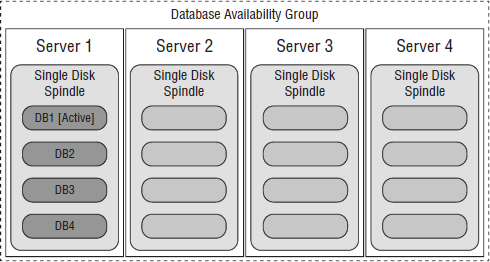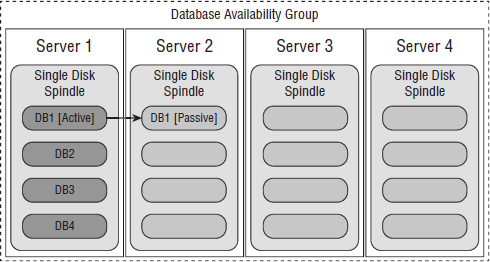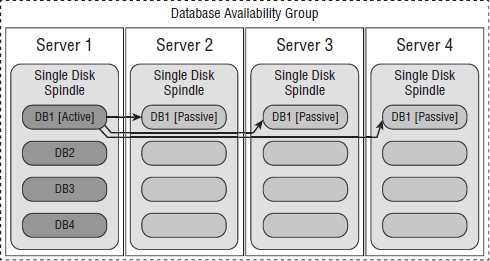INTERSITE REPLICATION BANDWIDTH
The bandwidth required for intersite replication
may be considerable. Let's consider an example of a four-node DAG, with
the first node containing all database copies, as shown in Figure 8.
As the first database copy is added, we have a replication unit of traffic, as shown in Figure 9.
As copies 3 and 4 are added, we have a multiple of this traffic, that is, replication traffic × 3, as shown in Figure 10.
FIGURE 8 DB1 before seeding

FIGURE 9 DB1 with one copy

FIGURE 10 DB1 with three copies

Exchange 2013 database
replication is quite similar to that of Exchange 2010 in that it uses a
single source as its replication master. Note that we are able to seed
from any active or passive node in the DAG. This means that Server 3
can seed from Server 2. Likewise, Server 4 can seed from Server 3, all
while Server 1 contains the active copy. If Server 3 and Server 4 are
in different datacenters, then the replication traffic for all
databases may outweigh the cost of placing two additional servers in
the DR site.
5. RESEED PLANNING
Database sizing is critical, because reseed times
are directly related to database sizes, especially if reseeds occur via
WAN connections.
Assuming that you have established the AFR
for your disks at 5 percent, you now have a potential number of reseed
events that require planning.
Reseed times vary greatly across different
networks. Therefore, it is vital to benchmark the time required to
reseed a database under different conditions, because the reseed time
factors directly into RPO and RTO times. Note that disks that are
allocated as spares for automatic reseed targets suffer the same rate
of failure as live production disks.
Your availability concerns for database availability group planning include the following:
- Correct database sizing, which may be an iterative process
- Calculating the appropriate number of database copies
- Calculating the appropriate number of database availability group nodes
- Placing the file share witness
- Distributing the databases to achieve optimum availability and load distribution as well as maintain quorum in case of an outage
- Deciding whether to use DAC mode
- Having sufficient bandwidth to support the number of copies required
- Planning for spare disks or LUNs to archive automatic reseeds
- Understanding reseed times and managing reseed expectations
- Understanding log replication requirements, so that RPO is not affected by a log replication build up